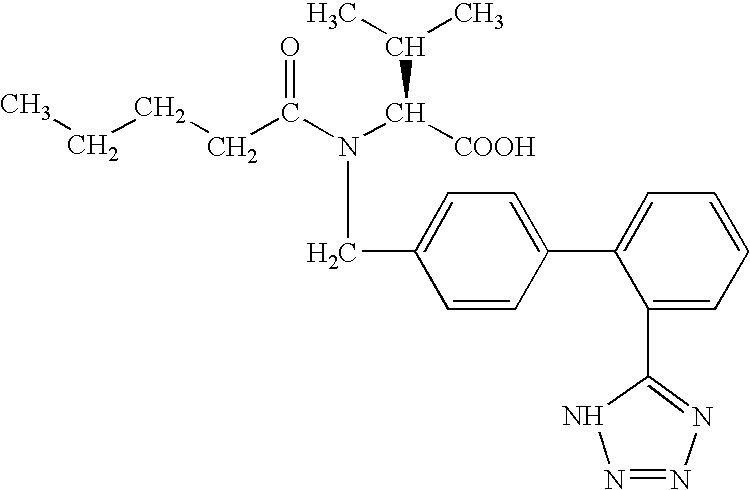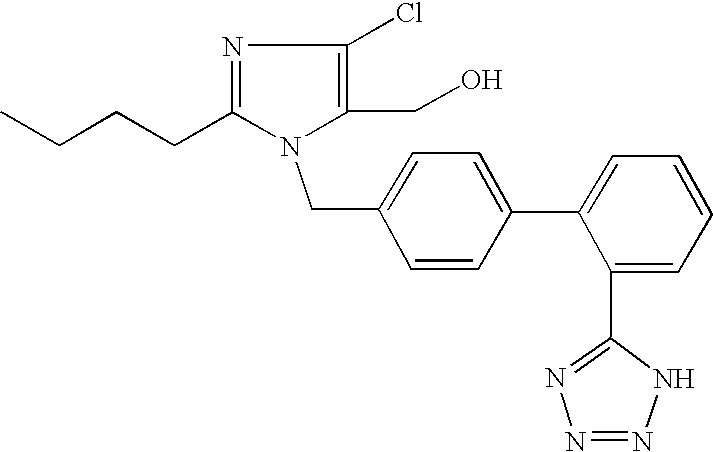Method of treatment and/or prophylaxis
a technology of angiotensin ii and a method of treatment, applied in the field of compounds, can solve the problems of high risk of developing this long-term complication of diabetes, no currently available treatment that is known to prevent/attenuate, and difficult to achieve tight glycaemic control for many diabetic patients, etc., to achieve the effect of increasing the solubility of compounds and increasing the viscosity of suspensions
- Summary
- Abstract
- Description
- Claims
- Application Information
AI Technical Summary
Benefits of technology
Problems solved by technology
Method used
Image
Examples
example 1
[0113] Induction of STZ-Diabetes
[0114] Adult male Dark Agouti (DA) rats were obtained from the Central Animal Breeding House, The University of Queensland (Brisbane, Australia). The DA rat was utilised because in contrast to other rodent strains (for example, the Sprague-Dawley rat), it is genetically deficient in functional CYP2D1, thus conferring a negligible capacity to O-demethylate oxycodone to the potent .mu.-opioid agonist, oxymorphone (Cleary et al., 1994, J Pharmacol Exp Ther, 271: 1528-1534). This compares favourably with the low extent of CYP2D6-mediated O-demethylation of oxycodone to oxymorphone in humans (Al-Dabbagh et al., 1981, J Pharm Pharnacol, 33: 161-164; Zysset et al., 1988, Biochem Pharmacol, 37: 3155-3160) whereby <5% of each dose of oxycodone is O-demethylated to oxymorphone, resulting in extremely low circulating plasma concentrations of oxymorphone (Poyhia Ret al., 1991, Br J Clin Pharnacol, 32: 516-518; Poyhia et al., 1992, Br J Clin Pharnacol, 33: 617-621...
example 2
[0119] Effect of Prophylactic Candesartan on the Development of Tactile Allodynia in STZ-Diabetic Rats
[0120] Candesartan Prevention Protocol
[0121] Candesartan treatment was initiated after STZ administration (day 0) but prior to the onset of diabetes. Specifically, candesartan-treated rats received this drug via once-daily oral gavage in one of two dosages: viz a high-dose (2 mg / kg / day) or a low dose (0.5 mg / kg / day). The 2 mg / kg / day dose was chosen on the basis that it is an anti-hypertensive dose both in rats with perfused Ang II-induced hypertension and also in the spontaneously hypertensive rat (SHR) (Nishikawa et al., 1994, Blood Press, Suppl 5: 7-14). The low-dose (0.5 mg / kg / mg) was included to investigate whether a sub-therapeutic dose (in terms of anti-hypertensive activity) of candesartan was efficacious for the treatment of PDN. Once initiated, oral once-daily candesartan was administered every day for 24 wks.
[0122] Three control experimental groups were also studied, inclu...
example 3
[0131] Opioid-Mediated Antinociception
[0132] The antinociceptive potencies of oxycodone and morphine for the relief of tactile allodynia were determined in all treatment groups. While full dose-response curves for each of subcutaneous (s.c.) morphine and oxycodone were determined in high-dose candesartan-treated STZ-diabetic rats and the candesartan-treated non-diabetic control rats, untreated STZ-diabetic rats and the low-dose candesartan-treated rats received single s.c. bolus doses (.apprxeq.ED.sub.50) each of oxycodone and morphine at 3, 9, 12 and 24 wks post-STZ administration. In all cases, opioids were administered by a single s.c. injection (100 .mu.L) into the dorsal region at the base of the neck whilst under light CO.sub.2 / O.sub.2 (50:50%) anaesthesia using a 250 .mu.L Hamilton syringe. For the STZ-diabetic treatment groups, the antinociceptive effects of morphine and oxycodone were determined at 3, 9, 12 and 24 wks, and at 3, 9 and 24 wks post-STZ administration, respect...
PUM
| Property | Measurement | Unit |
|---|---|---|
| weight | aaaaa | aaaaa |
| weight | aaaaa | aaaaa |
| weight | aaaaa | aaaaa |
Abstract
Description
Claims
Application Information
 Login to View More
Login to View More - R&D
- Intellectual Property
- Life Sciences
- Materials
- Tech Scout
- Unparalleled Data Quality
- Higher Quality Content
- 60% Fewer Hallucinations
Browse by: Latest US Patents, China's latest patents, Technical Efficacy Thesaurus, Application Domain, Technology Topic, Popular Technical Reports.
© 2025 PatSnap. All rights reserved.Legal|Privacy policy|Modern Slavery Act Transparency Statement|Sitemap|About US| Contact US: help@patsnap.com



